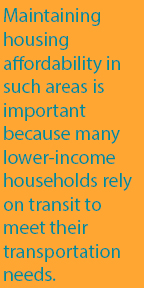In 2012 the Transportation Planning Board funded a study to evaluate the risk that development pressure and rising property values might permanently “price out” lower-income households near ten transit stations in the Washington region.
The study was carried out under the TPB’s Transportation/Land-Use Connections (TLC) Program which aims among other things to identify small-scale improvements to support compact mixed-use development patterns near rail or high-capacity bus transit lines. Maintaining housing affordability in such areas is important because many lower-income households rely on transit to meet their transportation needs.
Recently the study’s  findings were featured in an online webinar that attracted more than 50 participants from around the region and the country.
findings were featured in an online webinar that attracted more than 50 participants from around the region and the country.
The study looked at each station area’s likelihood of seeing new development current demographic characteristics and the probability of future demographic change current housing market strength and the existing availability of subsidized housing.
The ten station areas studied were current or planned Metrorail light rail streetcar or bus rapid transit stations in Prince George’s County the District of Columbia and the City of Alexandria where local planners thought future development could cause home prices and rents to escalate. The three jurisdictions partnered to apply jointly for the technical assistance study.
One of the station areas with the highest risk of losing affordable housing was the Anacostia Metrorail station in the District.
The study found a high likelihood of new development in the area with more than 70% of the land within a half-mile of the station having the potential to be redeveloped — more than any other station area studied — and construction of nearly 7000 new residential units underway or planned.
According to the study the area also had the lowest per capita income of all the station areas studied and among the highest shares of rental housing putting more of the area’s current residents at risk of eventually being priced out. Growing market pressure could also endanger the more than 2000 subsidized housing units already in the area.
Like Anacostia the Langley Park area in Prince George’s County near a stop on the planned Purple Line is home to a high proportion of low-income households. Longer-term development plans also put affordable housing there at risk.
But unlike Anacostia only about 40% of the land area in Langley Park has the potential for redevelopment while the vast majority of the nearly 5000 planned new residential units are slated for the long-term.
In Alexandria the area around the planned bus rapid transit station at the Mark Center was quite different than Anacostia or Langley Park with the highest per capita income among the study areas. However the area’s strong housing market is already leading to higher home and rent prices a trend that could put more of the area’s lower-income households at greater risk in the future.
the area around the planned bus rapid transit station at the Mark Center was quite different than Anacostia or Langley Park with the highest per capita income among the study areas. However the area’s strong housing market is already leading to higher home and rent prices a trend that could put more of the area’s lower-income households at greater risk in the future.
The study spells out a range of policy approaches for making affordable housing more available near transit stations depending on the unique characteristics and market pressures in individual station areas.
In places like Anacostia the report recommends efforts to preserve affordable housing stock already in place as planners prepare for large-scale redevelopment. In places like Langley Park it recommends a mix of preservation efforts and steps to make new affordable housing available but through smaller-scale piecemeal efforts rather than large-scale redevelopment.
The study’s findings are available online for anyone to access. The recent webinar part of the TLC Program’s Regional Peer Exchange Network is one way the TPB is reaching out to share the findings of TLC studies with policymakers practitioners researchers and other interested individuals. On March 7 the TPB will begin soliciting proposals for TLC studies to carry out in the coming year.